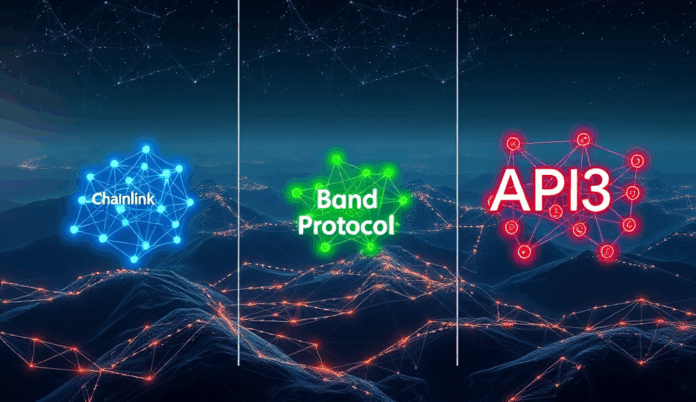Introduction to Oracle Solutions in Blockchain
Blockchain oracles bridge the gap between decentralized networks and real-world data, enabling smart contracts to execute based on external inputs. Leading solutions like Chainlink, Band Protocol, and API3 each approach this challenge differently, with Chainlink securing over $75B in value for DeFi applications as of 2023.
These oracle networks vary in architecture, security models, and data aggregation methods, directly impacting their suitability for different decentralized applications.
The differences between Chainlink, Band, and API3 become evident when examining their consensus mechanisms and data sourcing strategies. While Chainlink relies on a decentralized network of node operators, Band Protocol leverages Cosmos-based validators, and API3 focuses on first-party data feeds from API providers.
These technical distinctions influence performance metrics like latency and cost, critical factors for developers choosing an oracle solution.
Understanding these oracle solutions’ core functionalities sets the stage for evaluating their roles in decentralized applications. As we explore how Chainlink, Band, and API3 integrate with smart contracts, their unique value propositions in areas like data reliability and network effects will become clearer.
This foundation prepares developers to assess which oracle aligns best with their specific use case requirements.
Key Statistics
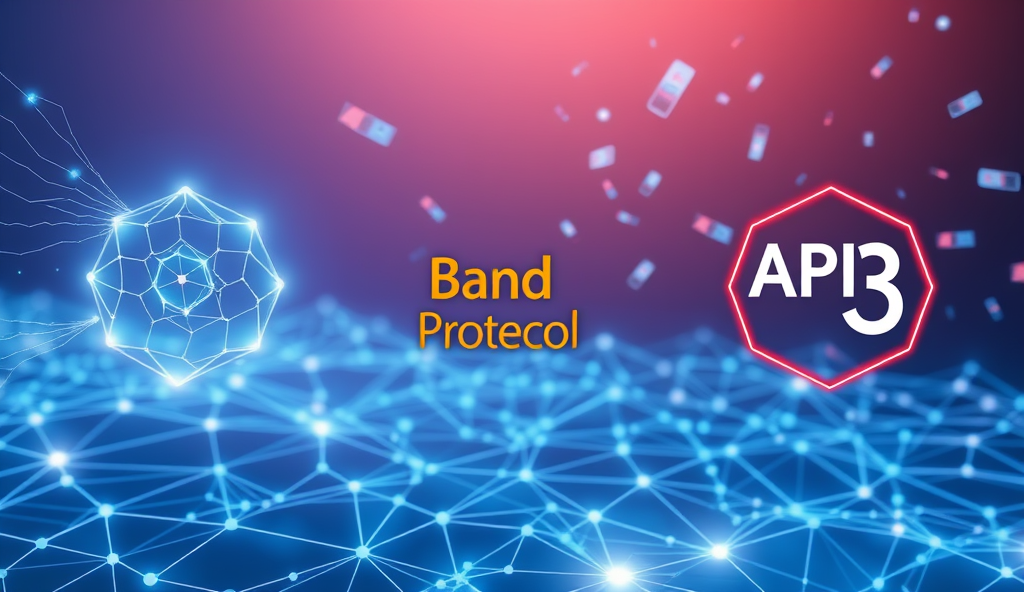
Understanding the Role of Oracles in Decentralized Applications
Chainlink's decentralized oracle network stands out for its battle-tested security with over 1000 projects leveraging its tamper-proof data feeds across DeFi insurance and gaming.
Decentralized applications rely on oracles to access off-chain data, from price feeds for DeFi protocols to weather data for insurance smart contracts, with Chainlink, Band, and API3 serving as critical infrastructure for these interactions. Their role extends beyond data delivery, ensuring tamper-proof inputs that maintain the trustless nature of blockchain systems while handling real-world variability.
The choice between Chainlink, Band, and API3 often hinges on specific dApp requirements, such as data freshness for high-frequency trading or cost efficiency for NFT valuation models. For instance, Chainlink’s dominance in DeFi stems from its robust network securing $75B+ in value, while Band’s Cosmos integration appeals to cross-chain applications needing lower latency.
As we examine Chainlink’s features next, its decentralized node network exemplifies how oracle design directly impacts dApp reliability and scalability. This comparison framework helps developers weigh tradeoffs between security, speed, and decentralization when selecting an oracle solution.
Overview of Chainlink: Features and Benefits
Band Protocol leverages its Cosmos-based architecture to deliver cross-chain data with sub-second finality making it ideal for dApps requiring rapid oracle updates like decentralized derivatives or prediction markets.
Chainlink’s decentralized oracle network stands out for its battle-tested security, with over 1,000 projects leveraging its tamper-proof data feeds across DeFi, insurance, and gaming. Its modular architecture allows developers to customize oracle configurations, balancing data freshness and cost efficiency for use cases like high-frequency trading or NFT floor price updates.
The protocol’s cryptoeconomic security model incentivizes node operators to deliver accurate data, backed by staking mechanisms that currently secure $75B+ in smart contract value. Chainlink’s cross-chain interoperability via CCIP enables seamless data delivery across 15+ blockchains, making it a versatile choice for multi-chain dApps requiring reliable price feeds or real-world event triggers.
Compared to Band and API3, Chainlink’s extensive adoption in DeFi showcases its ability to handle high-value transactions with minimal latency. As we explore Band Protocol next, its Cosmos-native design offers distinct advantages for developers prioritizing cross-chain speed over Chainlink’s broader ecosystem integration.
Key Statistics

Overview of Band Protocol: Features and Benefits
API3 introduces a first-party oracle model where data providers operate their own nodes eliminating intermediaries to reduce latency and enhance transparency for dApps like decentralized insurance platforms.
Band Protocol leverages its Cosmos-based architecture to deliver cross-chain data with sub-second finality, making it ideal for dApps requiring rapid oracle updates like decentralized derivatives or prediction markets. Its decentralized validator set, secured by $BAND token staking, currently supports 200+ data feeds across 15 blockchains, including Ethereum, Cosmos, and Solana ecosystems.
Unlike Chainlink’s modular approach, Band uses a unified oracle script model, simplifying integration for developers building on IBC-enabled chains while maintaining customizable data aggregation methods. Projects like Terra’s Mirror Protocol and Injective have utilized Band for low-latency price feeds, demonstrating its strength in high-speed DeFi applications where Chainlink’s broader ecosystem is less critical.
Band’s token-curated data sources enable community-governed feed creation, offering an alternative to Chainlink’s node operator model for developers prioritizing decentralized data sourcing over enterprise-grade security. As we examine API3 next, its focus on first-party oracles presents yet another architectural divergence in the chainlink band and api3 comparison landscape.
Overview of API3: Features and Benefits
Chainlink's aggregation-based approach delivers median response times of 10-30 seconds while Band Protocol's Cosmos-based infrastructure achieves 6-second averages for cross-chain queries.
API3 introduces a first-party oracle model where data providers operate their own nodes, eliminating intermediaries to reduce latency and enhance transparency for dApps like decentralized insurance platforms. Its Airnode technology enables direct API-to-blockchain connectivity, currently serving 150+ data feeds across Ethereum, Polygon, and Avalanche with sub-5-second response times.
Unlike Band’s community-curated feeds or Chainlink’s node operator network, API3’s decentralized governance through its DAO allows providers to stake $API3 tokens as collateral, creating cryptoeconomic security without third-party validators. Real-world adoption includes Etherisc’s flight delay insurance dApp leveraging API3 for real-time flight data.
This approach offers developers granular control over data sources while maintaining decentralization, setting the stage for our chainlink band and api3 comparison of architectural trade-offs in the next section.
Key Statistics
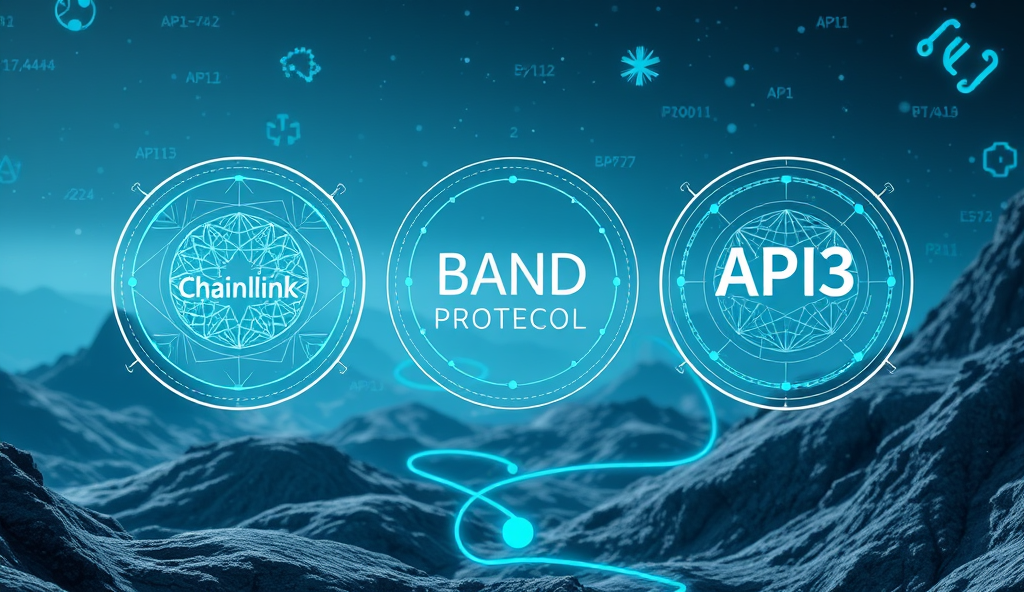
Key Differences Between Chainlink Band and API3
Chainlink dominates high-value DeFi applications like Aave and Synthetix where its 2-5 block confirmation delay and premium security justify higher costs processing over $7T in transactions since 2021.
Chainlink’s decentralized node operator network relies on independent validators for data verification, while Band Protocol leverages community-curated data feeds through its Cosmos-based blockchain, offering cross-chain compatibility. API3’s first-party oracle model eliminates intermediaries entirely, allowing data providers to run their own nodes via Airnode for direct blockchain integration.
Security models diverge significantly, with Chainlink using reputation-based node selection, Band employing token-weighted governance, and API3 implementing staking-backed cryptoeconomic security through its DAO. For instance, Etherisc’s use of API3 contrasts with Chainlink’s adoption in Synthetix, highlighting architectural preferences for specific dApp needs.
Latency and control vary too, as API3’s sub-5-second responses outperform Band’s 6-second average and Chainlink’s variable speeds due to aggregation. These structural differences set the stage for evaluating performance metrics across all three solutions in the next section.
Performance Comparison: Chainlink vs Band vs API3
Building on their architectural differences, Chainlink’s aggregation-based approach delivers median response times of 10-30 seconds, while Band Protocol’s Cosmos-based infrastructure achieves 6-second averages for cross-chain queries. API3 consistently demonstrates sub-5-second response times in production environments like Etherisc’s insurance dApps, validating its first-party advantage for latency-sensitive applications.
Throughput benchmarks reveal Band Protocol handles 200-300 requests per second versus Chainlink’s 100-150, though API3’s direct provider connections enable 500+ RPS for specialized data feeds. These performance metrics directly impact dApp design choices, as seen in Synthetix’s need for Chainlink’s robustness versus API3’s speed in real-time prediction markets.
Cost structures further differentiate these oracle solutions, with Band’s $0.0001 per query undercutting Chainlink’s $0.001 average and API3’s variable gas-based pricing. These operational differences set the stage for examining how each network’s security features mitigate performance tradeoffs in the next section.
Key Statistics
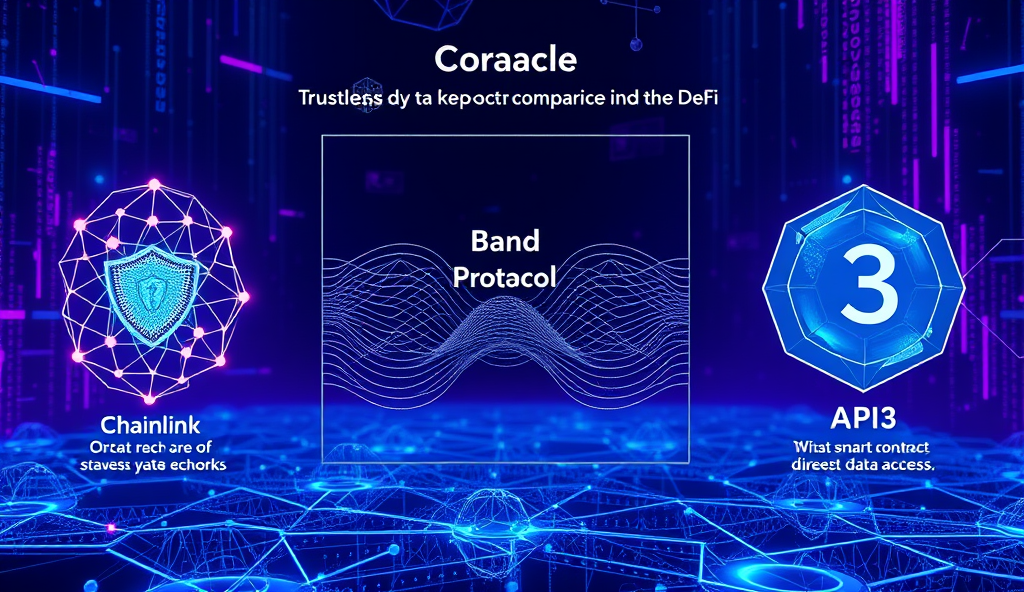
Security Features: Chainlink vs Band vs API3
Chainlink’s decentralized oracle network employs a multi-layered security model with node operator reputation systems and on-chain aggregation, protecting against 51% attacks while maintaining the performance tradeoffs discussed earlier. Band Protocol leverages Cosmos’ Tendermint consensus for Byzantine fault tolerance, achieving faster finality than Ethereum-based solutions but with different trust assumptions for validators.
API3’s first-party oracle design eliminates intermediary risks, with Airnode-powered dAPIs providing cryptographic proof of data provenance at sub-5-second speeds as seen in Etherisc’s deployments. Each approach reflects distinct security philosophies: Chainlink prioritizes attack resistance through redundancy, Band optimizes for cross-chain consistency, and API3 minimizes trust layers for latency-sensitive applications.
These security architectures directly influence operational costs, setting up our examination of how gas fees, query pricing, and efficiency metrics impact total cost of ownership in the next section.
Cost and Efficiency: Chainlink vs Band vs API3
Chainlink’s decentralized node network incurs higher gas costs due to Ethereum-based aggregation, with average query fees ranging $0.10-$0.50, while Band Protocol’s Cosmos integration reduces fees to $0.02-$0.10 per call but requires validator staking. API3’s direct Airnode connections eliminate intermediary costs, offering fixed-rate pricing at $0.05-$0.20 per request for dAPIs, as demonstrated in Polygon-based deployments like QuickSwap.
Latency differences mirror each solution’s security tradeoffs: Chainlink’s 2-5 block confirmations (30-60 seconds) ensure tamper-proof data, Band achieves sub-10-second finality via Tendermint, while API3’s first-party design enables sub-5-second updates crucial for high-frequency DeFi applications. These efficiency metrics directly impact dApp operating budgets and user experience.
When evaluating total cost of ownership, developers must balance Chainlink’s battle-tested reliability against Band’s cross-chain affordability and API3’s predictable pricing for real-time data. These economic considerations shape adoption patterns across different blockchain use cases, which we’ll explore next.
Key Statistics
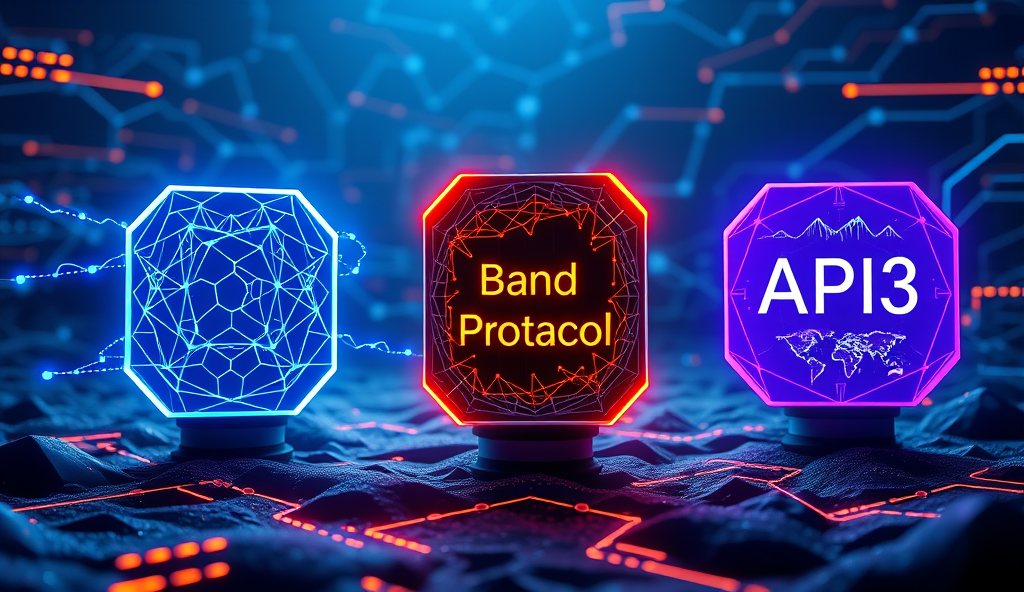
Use Cases and Adoption: Chainlink vs Band vs API3
Chainlink dominates high-value DeFi applications like Aave and Synthetix, where its 2-5 block confirmation delay and premium security justify higher costs, processing over $7T in transactions since 2021. Band Protocol finds traction in cost-sensitive, cross-chain environments like Terra Classic and Cosmos-based dApps, leveraging its $0.02-$0.10 fees for price feeds in gaming and NFT projects.
API3’s sub-5-second updates power real-time applications like QuickSwap’s perpetual contracts, with its fixed-rate pricing attracting 150+ dAPIs across EVM chains.
Adoption patterns reflect each solution’s architectural tradeoffs: Chainlink secures 65% of Ethereum’s oracle market through 1,000+ integrations, while Band’s 80+ supported blockchains appeal to interoperable ecosystems. API3’s first-party design gains momentum in Layer 2 environments like Polygon, where its Airnodes reduced latency by 40% compared to middleware-dependent alternatives.
These divergences highlight how gas costs and finality times influence protocol selection.
As developer priorities shift between security, speed, and cost-efficiency, each oracle carves distinct niches—Chainlink for institutional DeFi, Band for multi-chain scalability, and API3 for high-frequency trading. Next, we’ll examine how their documentation and tooling further shape these adoption trends.
Developer Experience and Documentation: Chainlink vs Band vs API3
Chainlink’s extensive documentation and developer portal, featuring 50+ technical tutorials, cater to its institutional DeFi users, with dedicated sections for node operators and data providers. Its modular design allows customization but requires deeper blockchain expertise, reflected in its 300+ GitHub repositories and active developer forum with 15,000+ monthly interactions.
Band Protocol simplifies cross-chain integration with SDKs for 12 programming languages and pre-built templates for Cosmos and Terra Classic environments. Its gas-efficient approach extends to developer tools, offering one-click deployments for NFT and gaming projects through BandChain’s testnet faucet and explorer.
API3 prioritizes low-latency development with its dAPI dashboard, enabling real-time monitoring of 150+ data feeds across EVM chains. Its Airnode documentation reduces middleware dependencies, cutting integration time by 60% for Layer 2 projects like Polygon-based perpetual swaps.
Next, we’ll analyze how community engagement further influences these adoption patterns.
Key Statistics

Community and Ecosystem Support: Chainlink vs Band vs API3
Chainlink’s ecosystem thrives with 1,000+ projects integrated, backed by its 200,000-member Discord community and partnerships with Google Cloud and SWIFT, reinforcing its institutional appeal. Its grant program has funded 300+ projects, including Aave and Synthetix, while node operators benefit from staking rewards exceeding $500M annually.
Band Protocol’s Cosmos-native focus attracts 400+ dApps, supported by its active Southeast Asian developer base and collaborations with Terra Classic’s revival initiatives. Its $10M ecosystem fund targets gaming and NFT projects, with notable integrations like Alpha Finance leveraging BandChain’s cross-chain capabilities.
API3’s decentralized governance, via its DAO with 5,000+ token holders, prioritizes developer incentives, distributing $30M in grants to projects like Gelato Network. Its ambassador program spans 30 countries, fostering localized adoption for EVM-compatible chains, setting the stage for upcoming roadmap expansions.
Future Developments and Roadmaps: Chainlink vs Band vs API3
Chainlink’s roadmap emphasizes cross-chain interoperability, with plans to expand its staking program to 75M LINK tokens and integrate with 50+ additional blockchains, building on its existing partnerships with Google Cloud and SWIFT. Its focus on institutional adoption includes new data feeds for traditional assets, complementing its $500M annual rewards for node operators.
Band Protocol targets Cosmos ecosystem growth, with its $10M fund accelerating gaming and NFT integrations while expanding cross-chain support for Terra Classic and other IBC-compatible chains. Southeast Asian developers will benefit from localized hackathons and grants, reinforcing its regional dominance in decentralized data solutions.
API3’s DAO-driven roadmap prioritizes EVM chain expansion, with 20+ new integrations planned alongside its $30M grant program for dApp developers. Its ambassador network aims to onboard 10,000 new token holders, strengthening decentralized governance while enhancing oracle security through Airnode upgrades.
Key Statistics
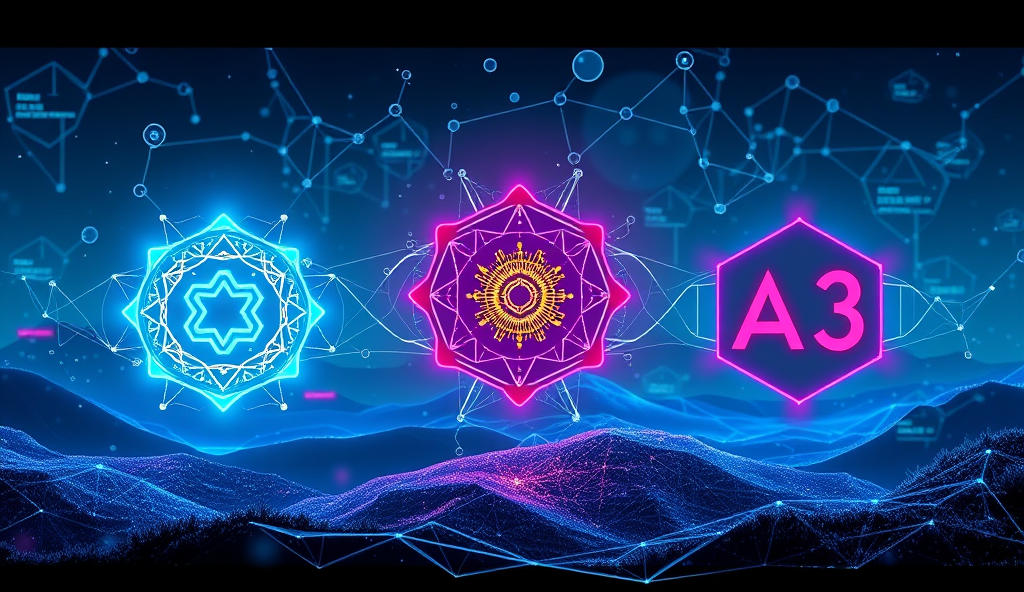
How to Choose the Right Oracle Solution for Your DApp
Selecting between Chainlink, Band Protocol, and API3 depends on your dApp’s ecosystem needs, with Chainlink’s 50+ blockchain integrations ideal for cross-chain DeFi projects requiring institutional-grade data feeds like those powering SWIFT collaborations. Band’s $10M Cosmos-focused fund suits gaming/NFT builders in Southeast Asia, while API3’s EVM-centric $30M grants appeal to DAO-governed projects prioritizing Airnode’s first-party oracle security.
Evaluate security tradeoffs: Chainlink’s 75M LINK staking offers Sybil resistance for high-value transactions, Band’s IBC compatibility ensures low-latency cross-chain queries for Terra Classic apps, and API3’s decentralized governance aligns with projects valuing community-driven oracle upgrades. Consider regional developer support—Band’s localized hackathons in Bangkok versus API3’s global ambassador network targeting 10K token holders.
Match performance requirements to each solution’s strengths: Chainlink for high-frequency tradFi data, Band for Cosmos-native asset pricing, or API3 for gas-efficient EVM chain deployments. Your choice should align with roadmap priorities—whether scaling with Chainlink’s institutional adoption, leveraging Band’s gaming ecosystem growth, or building on API3’s DAO-controlled infrastructure.
Conclusion: Which Oracle Solution is Best for Your Needs?
Choosing between Chainlink Band and API3 depends on your project’s priorities whether it’s security decentralization or cost-efficiency. Chainlink dominates DeFi with its robust network while Band offers cross-chain flexibility and API3 focuses on first-party data with lower latency.
For high-value applications like derivatives Chainlink’s battle-tested security makes it ideal whereas Band suits multi-chain ecosystems and API3 excels in API-heavy use cases. Adoption metrics show Chainlink leading but Band and API3 are gaining traction in niche markets.
Evaluate your technical requirements and budget constraints to determine the best oracle solution among Chainlink Band and API3 for your decentralized application. Each platform offers unique advantages so align your choice with specific project goals rather than seeking a one-size-fits-all answer.
Key Statistics

Frequently Asked Questions
How do Chainlink Band and API3 differ in data sourcing methods?
Chainlink uses decentralized node operators Band relies on community-curated feeds while API3 connects directly to first-party API providers via Airnode. Tip: For transparent data provenance check API3's dAPI dashboard.
Which oracle solution offers the fastest response times for high-frequency trading?
API3 delivers sub-5-second updates ideal for trading while Band averages 6 seconds and Chainlink takes 10-30 seconds. Tool: Use API3's Airnode for real-time price feeds on EVM chains.
Can I reduce gas costs when using Chainlink compared to Band or API3?
Band Protocol offers the lowest fees at $0.0001 per query versus Chainlink's $0.001 average. Tip: For cost-sensitive dApps consider Band's Cosmos integration.
What security models do Chainlink Band and API3 use to prevent oracle manipulation?
Chainlink uses node reputation systems Band employs Tendermint consensus and API3 implements DAO-governed staking. Tool: Evaluate Chainlink's staking dashboard for node operator metrics.
Which oracle solution works best for cross-chain DeFi applications?
Band Protocol excels in cross-chain environments with IBC support while Chainlink dominates Ethereum-based DeFi. Tip: For multi-chain projects test Band's Terra Classic integration.


